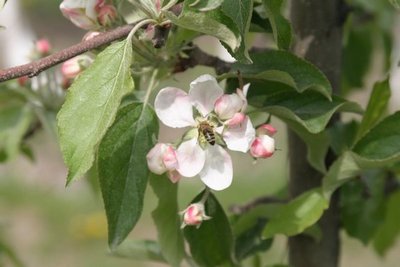August 30, 2010
In cracking apple DNA code, Apple Cup rivals join in international team effort
The DNA code of the Golden Delicious apple has been sequenced for the first time.
A global team of 86 scientists from Italy, France, New Zealand, Belgium and the United States have published their findings on the apple genome in this week’s issue of Nature Genetics. Researchers from Washington State University and the UW were among the contributors.
The breakthrough could help agricultural scientists selectively breed new apple varieties that have desired traits –in appearance, color, taste, and texture — and that are more resistant to disease and drought.
Apple, and its close relative, the pear, have 17 chromosomes. This is about twice the number of chromosomes in other plants from this same family. Sequencing the apple’s genome revealed that large lengths of apple chromosomes are copied in other chromosomes. Many of the duplicate genes in apple trees are related to fruit development.
The apple DNA study suggests that a major step in the evolution of the apple coincided with a catastrophic event some 60 million years ago, and may have been a survival response during a time of mass extinctions.
Washington State University horticultural genomicist Amit Dhingra coordinated the Washington state portion of the international study. This part of the study included sequencing and analyzing a unique version of the genome of the Golden Delicious apple in which all duplicated chromosomes are genetically identical. This information was used to validate the sequence of the more complicated Golden Delicious apple in which duplicated chromosomes are not identical.
Microbiologist Roger Bumgarner’s lab at the UW provided the initial sequencing expertise and capability to the project, which was later complemented by sequencing expertise in the Dhingra genomics lab.
“UW is a world leader in medical research and WSU is a world leader in agricultural research,” said Bumgarner. “Technological advancements and techniques initially used to study medically important genomes and problems can be rapidly applied to genomes and problems of agricultural importance. We both had something to contribute and to learn from one another. I think there are many more opportunities for such collaborations to develop in the coming years.”
The international Apple Genome Study was coordinated by Riccardo Velasco at the Edmund Mach Foundation in Italy.
The domestic apple is the main fruit crop of the world’s temperate regions. Apple is a member of the plant family Rosaceae which includes many other economically important species, including cherry, pear, peach, apricot, strawberry, and rose, to name just a few.
After the apple sequencing was completed, WSU computational biologist Ananth Kalyanaraman compared its genome with that of pear, peach and grape to identify the differences and commonalities between these fruit crops.
The state of Washington accounts for approximately 60 percent of total apple production in the United States. Rosaceae fruit production is a multi-billion dollar industry in the state.
Where did the apple originate? Scientists have long wanted to know — and have for years argued vehemently about — the ancestor of the modern domesticated apple. The question is now settled. Malus sieversii, native to the mountains of southern Kazakhstan, is the apple’s wild ancestor, according to the Nature Genetics paper. It appeared about 4,000 years ago. There are now more than 7,500 known varieties of apple.
“Having the apple genome sequence will greatly accelerate our ability to define the differences between apple cultivars at the genetic level,” said Kate Evans, an apple breeder based at the WSU Tree Fruit Research and Extension Center. “This will allow us to exploit these differences and target areas of diversity to incorporate into the breeding program. We hope these will result in cultivars that are better for consumers and for long-term, sustainable production.”
“Before genome sequencing, the best we could do was correlate traits with genes. Now we can point to a specific gene and say, ‘This is the one; this gene is responsible for this trait’. That trait of interest might be, for instance, a disease. Or the trait might be for something desirable, like flavor in a piece of fruit. We are already working on finding physiological solutions to issues like bitter pit in current apple varieties with the gene-based information available to us,” Dhingra said
Dan Bernardo, dean of the WSU College of Agricultural, Human, and Natural Resource Sciences, said, “The Washington apple is an icon of quality around the globe. Washington is a natural home for the advanced science necessary to map the tree fruit genome and actively study how it functions.”
The United States portion of the apple genome project was supported by a National Research Initiative competitive grant from the USDA National Institute of Food and Agriculture and the Washington Tree Fruit Research Commission. Additional funding came from the WSU Department of Horticulture and Landscape Architecture and the Agriculture Research Center at WSU.



